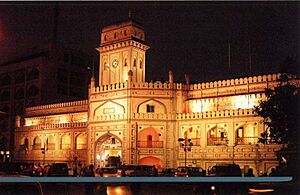History of Surat facts for kids

Surat began as a city in the late medieval period. It slowly grew into a very important port city during the time of the Mughal Empire. People lived in this area as early as 300 BCE. Later, the Maratha rulers fought and defeated the Mughals in the Battle of Surat. After that, the Dutch took control, and the city became known as Dutch Suratte.
Contents
Early History of Surat
Between the 12th and 15th centuries, different groups attacked Surat. The Portuguese Empire also attacked Surat in 1512 and again in 1530. A Portuguese traveler named Duarte Barbosa visited Surat in 1514. He wrote that Surat was a major seaport. Many ships from Malabar often visited it.
Gujarat Sultanate's Influence
Many early European travelers wrote about an important person named Malik Gopi. He was a Brahmin who helped settle the region and start the city. Malik Gopi might have been a governor under the Gujarat Sultanate.
In 1516, Gopi built an artificial lake called Gopi Talav. This lake helped store water for the city. The area he developed was named Gopipura to honor him. The Sultan of Gujarat, Muzaffar Shah II, gave Gopi the special title Malik for his work.
For a long time, the town Gopi developed did not have a name. After asking astrologers, he suggested naming it "Suraj" or "Suryapur." By 1520, the city's name became Surat. The king changed the name to "Surat" because he did not like the Hindu sound of "Suraj." "Surat" comes from Arabic words for chapters in the Quran. Gopi is also mentioned in Portuguese writings as the "Lord of Surat and Bharuch."
Surat Under the Mughal Empire
In 1573, the Mughals took control of Surat. It became the richest port in their empire. Many people used this port to travel for the Hajj pilgrimage.
Even though Surat was wealthy, it looked like a busy trading town. It had mud-and-bamboo houses and winding streets. However, along the river, there were grand houses and warehouses. These belonged to rich local merchants and traders from Turkey, Armenia, England, France, and the Netherlands.
Travelers were often surprised to see hospitals for animals like cows, horses, flies, and insects. These were run by religious Jains. Some streets were narrow, while others were wide. In the evenings, especially near the market, the streets were full of people and merchants selling their goods.
Surat had many people during the Mughal era. Its population grew even larger during the monsoon season. This was when ships could safely come and go from the ports. In 1612, England set up its first Indian trading factory in Surat. The Maratha king Shivaji attacked and took over the city twice. The first attack happened in 1664.
Maratha Empire's Attacks
The Marathas attacked Surat two times. The first attack was in January 1664. The second attack happened in October 1670.
Colonial Period in Surat
During the time of European rule, Surat became a major trading center for India. It exported gold and cloth. Its main industries were building ships and making textiles. The coast of the Tapti River, from Athwalines to Dumas, was especially used for shipbuilding.
Surat continued to be a rich city until Bombay (now Mumbai) grew in importance. After that, Surat's shipbuilding business slowed down. The city itself slowly declined throughout the 18th century. Between 1790 and 1791, a disease outbreak killed 100,000 Gujaratis in Surat.
Both the British and the Dutch wanted control of the city. But in 1800, the British took over Surat. The Andrews Library was built during this time.
In 1837, a huge fire destroyed 9,737 houses. More than 500 people died. It was the worst fire in the city's history.
By the mid-1800s, Surat had about 80,000 people and was not growing much. But when India's railways started, the city began to become successful again. Silks, cottons, fancy fabrics, and items made of gold and silver from Surat became famous. The old art of making fine muslin cloth also came back.
Surat After Independence
After India became independent in 1947, new schools and colleges were started in Surat. These included the NIT Surat and Veer Narmad South Gujarat University.
See also
- Timeline of Surat



